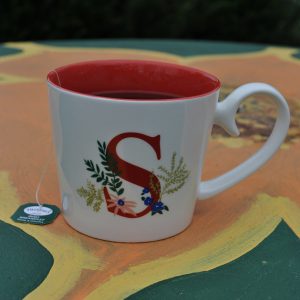
by Samantha Kennedy | Mar 3, 2020
I recently bought some new shirts and last night, before washing them for the first time, I took a peek at their care instructions. I always do this prior to laundering anything new so I do not do anything that can harm my new duds. Proper laundry care is a must!
This is what one of the labels looked like:

Clothing care labels provide instructions for the proper care of your clothes to help you keep them looking their best for as long as possible. (Photo source: Samantha Kennedy, UF/IFAS Extension)
As I looked at all the labels, I was reminded once again that doing the laundry can be more complicated than simply throwing clothes in the washing machine, adding detergent, turning on the machine, and walking away. (I learned this lesson the hard way after I ruined a brand new blouse in the washing machine when it was supposed to be dry cleaned only.)
Care labels contain both written and symbolic instructions. Sure, I can read the written instructions and am fairly good at following directions, but what the heck do all those symbols mean? So I decided to look them up. After all, I did not study hieroglyphics and I wanted to be sure I treated my new clothes right.
Turns out, there are a LOT of laundry care symbols. And if you are anything like me, I know what very few of them actually mean. With that in mind, here is a comprehensive chart of the symbols you may find on your clothing care labels:

These laundry care symbols are standardized across the United States. and are required to be added to clothing care labels by the Federal Trade Commission, as appropriate. (Photo source: Miami University)
(Ctrl + click on the chart to open a larger version of it in a new tab.)
The Federal Trade Commission (FTC) actually regulates the use of these symbols in order to ensure standardization across the clothing industry. Certain types of apparel are excluded from having to use these symbols, such as hats, shoes, gloves, handkerchiefs, suspenders, neckties, and belts.
According to the FTC, all care labels must include instructions for washing and/or dry cleaning a particular item. There are five elements of washing:
- Washing by hand or by machine
- Bleaching
- Drying
- Ironing
- Other warnings (e.g. wash with like colors, wash separately, etc.)
In the sample label above (click here for a larger version), the symbols, from left to right, stand for machine wash below 80 degrees F (30 degrees C), do not bleach, tumble dry low heat, iron on low temperature, and do not dry clean.
I know it seems like the laundry is never done, and who has the time to follow all the specific care instructions, right? Believe me, I understand. And it is not realistic to wash every piece of clothing according to its specific instructions. However, taking the time to look at the care labels and familiarizing yourself with the most common symbols can help you avoid ruining perfect good clothes by doing something that can damage the fabric.
For a downloadable laundry care symbols chart, here is a nice one from the University of Tennessee Extension Service.
Extension classes are open to everyone regardless of race, creed, color, religion, age, disability, sex, sexual orientation, marital status, national origin, political opinions or affiliations.

by Samantha Kennedy | Jan 13, 2020

A delicious cup of hot tea is a great way to start the day and can provide a daily dose of health-promoting antioxidants.
(Photo source: Samantha Kennedy)
For me, there’s nothing better than a hot cup of tea on a chilly morning – or any morning, really. The rich flavor and fragrant steam work together to perk me up and help me get ready to take on the day. And in the evening, a nice, warm cup of tea can also help me relax before settling down to sleep. The key is finding the right kind of tea for the task.
Types of Tea
There are five major types of tea: green, black, white, red, and herbal. All non-herbal teas are produced from the leaves of the warm-weather evergreen tea plant, Camellia sinensis. The degree of processing or oxidation of the leaves determines which type of tea is produced.
Green tea is very minimally processed and the leaves are not oxidized, which results in its light green color and delicate taste. Green tea is very low in caffeine. Green tea is very popular in Asian cultures, but has gained increased popularity around the world.
Black tea has a very rich flavor and the highest caffeine levels of all types of tea due to the long processing time. The leaves are fully oxidized, resulting in the rich amber color and rich flavor. Some of the most popular and common types of black tea are Early Grey, English Breakfast, and Darjeeling.
Red tea is oxidized for less time than black tea, resulting in a milder flavor and lighter color. The flavor intensity and caffeine levels of red tea fall somewhere between green and black tea. The most common type of red tea is Oolong, which is very popular in Asia.
White tea is produced from young tea leaves and unopened buds. The resulting brew has a velvety, delicate flavor and very light, “white” color. Since it is so minimally processed, it has very little caffeine.
Herbal tea is not produced from the leaves of the tea plant. Instead, herbal teas are created through a combination of herbs and other plants, often utilizing the leaves, stems, and roots. Herbal tea does not have caffeine and is often used medicinally to treat a variety of ailments.
Potential Health Benefits
The health benefits of tea, especially green tea, have long been touted. The fermentation process involved in green tea production increases the levels of a type of antioxidants called polyphenols, which can help reduce cell damage caused by the byproducts of regular cell production in the body.
According to two Harvard School of Public Health studies, those who drank tea regularly showed a decreased risk of developing Type 2 diabetes compared to non-tea drinkers. The substances in tea, such as polyphenols, have also been linked to lower risk of cardiovascular disease, cancer, and stroke and have been shown to help lower blood pressure and cholesterol.
One note of caution: Some chemicals in tea are known to bind to iron, thereby decreasing its absorption in the body. Those who suffer from iron-deficiency anemia may want to consult a physician before increasing their tea consumption.
Tea drinking is not a cure-all. However, drinking tea as part of an overall healthy diet may provide added health benefits that can help promote healthy cells and blood vessels.
So take the time to smell (and sip and savor) the tea while toasting to better health. Happy brewing!
Additional Resources:
Health benefits linked to drinking tea (Harvard Medical School)
Tea: A cup of good health? (Harvard Medical School)
Take Time for Tea: For Health and Well-being (North Dakota State Extension)
Extension classes are open to everyone regardless of race, creed, color, religion, age, disability, sex, sexual orientation, marital status, national origin, political opinions or affiliations.

by Samantha Kennedy | Nov 7, 2019
Now that it is finally starting to feel like autumn here in north Florida, I have begun to see more and more fall-themed decorations. While the leaves may not change color as much as they do farther north, we do have easy access to another autumn staple: pumpkins.
Pumpkins can be grown in Florida. They are part of the cucurbit family of vegetables that includes other winter and summer squashes such as acorn, butternut, lemon, and zucchini. The four species of pumpkins include pepo, moschata, mixta, and maxima. They have a coarse, strongly flavored flesh and rinds whose hardness falls between that of winter (hard) and summer (soft) squashes.

Pumpkins are an autumn staple, providing not just festive decorations, but also nutritious additions to meals and desserts. (Photo source: Amy Stuart, UF/IFAS)
The three major categories of pumpkins are carving pumpkins, pie pumpkins, and ornamental pumpkins. Each type has its own unique characteristics. Carving pumpkins are large and have smooth, orange, and slightly ribbed skin. Pie pumpkins are smaller, have a sweeter taste, and bright, firm flesh. Ornamental pumpkins are tiny, about 3-4 inches in diameter, and can be orange, white, or variegated.
Pumpkins, like tomatoes, are botanically fruits, but are commercially considered vegetables. While their rinds are generally not edible, both their flesh and seeds can be eaten. Pumpkin can be canned, pureed, roasted, and made into soups, stews, and, of course, pies. Pumpkin seeds are most commonly roasted and eaten on their own as a snack or added to salads and other dishes for a bit of delicious crunch.
As a food source, pumpkins are very nutritious. They are low in fat, calories, sugar, and sodium. A single serving of pumpkin contains 10% of the daily value of potassium and 3 grams of fiber, both of which are vital to good health. Pumpkin also contains a variety of other beneficial nutrients such as vitamin C, calcium, and iron. However, pumpkin is a vitamin A powerhouse. One serving contains 250% of the daily value of this vitamin, which helps promote healthy eyes, skin, and bones. In fact, the beta carotene in pumpkins, which our bodies convert to vitamin A, is what gives pumpkins their vibrant orange color.
According to the University of Florida IFAS, most pumpkin varieties need around four months to reach maturity. To be ready for Halloween, pumpkins should be planted no later than early July. Spring pumpkins planted in March or April can be stored for use in October and November if stored properly in a cool, dry place.
When carving pumpkins, be sure to use the proper tools. Remove the seeds and pulp, and save the seeds for roasting and/or planting. When preparing pumpkins for canning, use smaller sugar or pie pumpkins. Cut them into cubes and do not mash or puree them. When making pumpkin pie, choose the smaller, sweeter pumpkins for the best flavor. Commercially canned pumpkin also can be used to make pumpkin pie.
One final note: do not confuse gourds and pumpkins. While, technically, all pumpkins can be considered gourds, not all gourds are edible. What we think of as gourds are usually the hard, bumpy things with the hollow center that are commonly found in fall decorations. While they are part of the same cucurbit family, they are primarily grown for ornamentation, utensils, and general interest.
Nothing says autumn like a few festive pumpkins. Whether used for a scary Halloween jack-o’-lantern, as a centerpiece for fall decorations, or as an ingredient in a delicious fall dessert, pumpkins are definitely the stars of autumn.
For more information about pumpkins, please call Samantha Kennedy, Family and Consumer Sciences agent, at 850.926.3931.
Additional Resources:
Florida Pumpkins – UF/IFAS Extension
Perfectly Pumpkin Recipe Collection – University of Nebraska – Lincoln Extension
Pumpkin carving: The history of the jack-o’-lantern – Michigan State University Extension
Extension classes are open to everyone regardless of race, creed, color, religion, age, disability, sex, sexual orientation, marital status, national origin, political opinions or affiliations.

by Samantha Kennedy | Aug 24, 2019
If you are anything like me, you pride yourself on keeping your kitchen safe and clean. Everything is tidy and in its place, there is no expired food in the pantry or refrigerator, and all the appliances are clean and free of debris.
But really. How clean is your kitchen? Out of curiosity, I recently graded the cleanliness of my kitchen using this handy checklist from Rutgers University. And while I received a pretty good grade, there were a few things I discovered I was not doing correctly. As a food safety instructor, I was ashamed of myself!

The safest and most sanitary way to dry your hands is with disposable paper towels. Never use a dishtowel for anything other than drying dishes. (Photo source: Samantha Kennedy)
The top five things I overlooked are:
- While the inside of my microwave oven was clean and free of debris, I failed to pay enough attention to the door. It was a little grubby. While it may not seem important to keep it clean since it does not come in contact with food, gunky buildup from food and other sources can harbor bacteria. Be sure to always keep the door clean!
- I have a bad habit of using the same dishtowel to dry my hands that I use for other functions in the kitchen. The best food safety practice is to either use paper towels to dry your hands or have a designated towel for hand drying. In fact, dishtowels should only be used to dry dishes, not to wipe down countertops or clean up spills.
- While I hate to admit it, I have sometimes resorted to thawing foods on the counter when I have realized that one of the ingredients for that night’s dinner is still in the freezer. THIS IS A VERY UNSAFE PRACTICE! Thawing foods at room temperature (i.e. on the counter) exposes foods to the Temperature Danger Zone, which can encourage the growth of pathogens. The Temperature Danger Zone is the range of temperatures between 41 and 135 degrees F. Keep cold foods below 41 degrees and hot foods above 135 degrees to reduce the risk of foodborne illness. There are only 4 acceptable methods to safely thaw foods:
- In the refrigerator.
- Under running water. (NOTE: The water temperature must always be less than 70 degrees F.)
- In the microwave. (NOTE: The food must be cooked immediately after thawing.)
- During the cooking process.
- I do not actually store a lot of leftovers. As a single person, I generally prepare small meals that can be eaten in one sitting. However, on those occasions when I do have leftovers, I do not always label them with the date. Leftovers stored in the freezer should be labeled with what it is and when it was put into the freezer. Refrigerated leftovers should not be kept longer than 7 days. Frozen leftovers should not be kept longer than 6 months.
- My cats are allowed in the kitchen and even on the countertops. While I always sanitize the surfaces before I prepare food, the best food safety practice is to prevent pets from coming into contact with countertops and other food contact surfaces.
How do you think your kitchen would fare? I encourage you to take a few minutes to grade your own kitchen to make sure you are doing everything you can to keep your kitchen as clean and sanitary as possible.
For more information about food and kitchen safety, please visit https://www.foodsafety.gov/.

by Samantha Kennedy | Jul 2, 2019

Picnics are a great way to share food and fun with friends and family. By following a few simple food safety tips, you can make sure foodborne illness doesn’t crash your party. (Photo source: UF/IFAS file photo)
There are few things more iconic during summer than a picnic. There’s just something fresh and fun about sharing a meal in the park or at the beach with family and friends. But just because you’re enjoying the warm, gentle breeze doesn’t mean you should throw caution to the wind. By following a few simple food safety tips, you can ensure that your perfectly planned picnic doesn’t make you sick.
Plan appropriately. Not all foods are picnic-appropriate. Anything that requires a lot of perishable ingredients and/or a lot of preparation should be avoided. Stick with foods that require little or no cooking and that contain just a few ingredients. Foods such as fruits and vegetables (especially whole ones), hard cheeses, peanut butter and jelly, cereal, bread, and crackers are ideal picnic items. Anything made with commercially processed custard or mayonnaise will stay safe as long as it is kept cold.
Pack it safely. Use a cooler, if possible, and store cold foods together so they can help each other stay colder longer. Use ice or frozen gel packs to help keep foods cold. Pack foods directly from the refrigerator into the cooler; don’t leave them sitting out before packing. Store ready-to-eat foods separately from raw meats. If packing up hot foods, be sure to keep them in a thermos or other insulated dish. DO NOT store them in the same container as the cold foods. Paper towels, disposable utensils, and a food thermometer are ideal picnic accessories. Remember, keep cold foods below 41 degrees F and hot foods above 135 degrees F. Do your best to keep the cooler away from direct sunlight by storing it in the shade and be sure to replenish the ice and/or frozen gel packs when they melt. If possible, store drinks in a separate cooler so cold foods are not exposed to warm air with frequent openings of the lid to retrieve drinks. This also reduces the risk of cross-contamination, with fewer hands reaching into the food cooler.
Prepare it carefully. All food items should be kept at the proper temperature at all times. When cooking raw meats, use separate plates for the raw and cooked products and clean and sanitize utensils between uses. Cook meat to the proper recommended internal temperature to ensure doneness and safety. Click here for a list of recommended internal cooking temperatures.
Clean up quickly. Discard any perishable foods that have been left out for longer than two hours. In really hot weather (generally above 90 degrees F), foods should not be left out longer than one hour. Keep food protected in storage containers such as coolers and lidded dishes to minimize contamination from flies and other pests. Serve small portions of food at a time and keep the rest in the cooler.
Picnics are an important part of summer and with just a little bit of planning and a few useful tips and tools, they can be safe and delicious for everyone!
Related links:
Food Safety at Tailgating (University of Florida/IFAS)
Picnic Safety (Iowa State University)
Checklist for the Perfect Summer Picnic (foodsafety.gov)
Extension classes are open to everyone regardless of race, creed, color, religion, age, disability, sex, sexual orientation, marital status, national origin, political opinions or affiliations.











